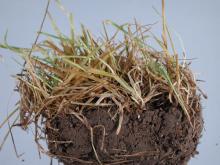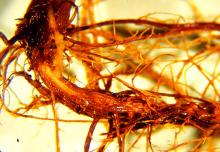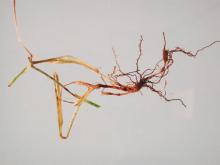Hosts Turf with strong rhizomatous-growth habit such as Kentucky bluegrass and fine fescue.
Cause The soilborne fungus Ophiosphaerella korrae (formerly Leptosphaeria korrae) infects turf with excessive rhizomatous-thatch accumulation. Using soil organic matter as a food base, the fungus infects roots, rhizomes, and the base of shoots in the fall during periods of cool, wet weather. The pathogen forms dark strands of mycelium that run parallel to the root axis. Infections typically develop in the fall compromising the turfgrass rooting system; however, symptoms are typically not visible until the following summer when heat and drought stress is coupled with the comprised rooting system. It overwinters in infected plant material. It has become a common problem in eastern and western Washington and in central and eastern Oregon, particularly on 2- to 5-year-old Kentucky bluegrass turf established from sod. Turf established from seed also has shown the disease but much less frequently. The disease also has been found in Idaho and British Columbia.
Symptoms Dead circles and arcs ranging from several inches to several feet in diameter are most obvious during the summer months during periods of heat and drought stress. When the disease is active, the affected areas' margin is reddish brown. Short-necked, black pseudothecia sometimes are found on infected crowns and roots. Weeds or resistant grass species often invade the dead turf area. Necrotic ringspot can be confused with yellow patch and Microdochium patch because the diseases have similar foliar symptoms and occur in autumn and spring. Unlike the latter two diseases, whose symptoms usually subside in late spring, necrotic ringspot can occur throughout the growing season and is characterized by a blackening of roots and rhizomes and by dark-brown ectotrophic hyphae on dying roots, rhizomes, and crowns. In the later stages of infection, black fruiting bodies (pseudothecia) occasionally are on these tissues.
Cultural control
- Use mixtures of two or more grass species and two or more resistant cultivars to reduce the possibility of disease.
- No Kentucky bluegrass cultivar is immune to this disease; however, cultivars differ in susceptibility. Cultivars Alpine, NE80-88, Princeton-104, Mystic, Joy, and I-13 consistently have less disease than HV-97 (Cocktail), Annika, Amazon, Opal, Trampas, and Sydsport. Avoid the latter cultivars.
- Aggressive organic-matter management, annual core cultivation and vertical mowing, is essential for management of this pathogen within rhizomatous grasses.
- Maintain good growing conditions for turf by proper fertilizing and watering.
- Avoid high-nitrogen and quick-release fertilizers.
- Avoid over-watering turf in the fall months. If symptoms are observed in the summer months, light and frequent irrigation will be required to sustain growth of the turf with a previously compromised rooting system.
- Sulfur applications are ineffective in controlling necrotic ringspot on bluegrass; however, a balanced fertilizer that includes sulfur helps turf recover.
Chemical control Use in conjunction with cultural practices. Research in the Pacific Northwest has shown that one (1) or two (2) applications of some Group 3 fungicides effectively control the disease when the equivalent of 0.5 to 1 oz active ingredient is applied per 1,000 sq ft in late fall or spring. For optimum control of problematic sites, initiate fungicide applications in the fall months prior to the development of symptoms.
Products available in home packaging:
- Infuse Systemic Disease Control at 9 fl oz/1 gal water/250 sq ft of lawn. Group 3 fungicide. H
- Spectracide Immunox Multi-Purpose Fungicide Spray Concentrate for Gardens at 7 fl oz/gal water over 500 sq ft. Group 3 fungicide. H
Products available for commercial use:
- Chipco 26019 FLO at 8 fl oz/1,000 sq ft. Group 2 fungicide. 12-hr reentry.
- Disarm 480 SC at 0.27 to 0.36 fl oz/1,000 sq ft. Group 11 fungicide. 12-hr reentry.
- Eagle 20 EW at 2.4 fl oz/1,000 sq ft. May produce a growth regulation effect on Kentucky bluegrass. Group 3 fungicide. 24-hr reentry.
- Fame SC at 0.3 to 0.4 fl oz/1,000 sq ft. Group 11 fungicide. 12-hr reentry.
- Floxcor at 0.27 to 0.36 fl oz/1,000 sq ft plus an adjuvant. Group 11 fungicide. 12-hr reentry.
- Heritage at 0.2 to 0.4 oz/1,000 sq ft. Group 11 fungicide. 4-hr reentry.
- Maxtima at 0.6 to 0.8 fl oz/1,000 sq ft. Group 3 fungicide. 12-hr reentry.
- Mirage at 2 fl oz/1,000 sq ft. Lightly water into root zone after application. Group 3 fungicide. 12-hr reentry.
- Monsoon Turf at 0.6 fl oz/1,000 sq ft. Group 3 fungicide. 12-hr reentry.
- Propiconazole-based products applied twice in early spring. Group 3 fungicides.
- Banner MAXX at 4 oz/1,000 sq ft. 12-hr reentry.
- PropiMax EC at 1.45 fl oz/1,000 sq ft. 12-hr reentry.
- Rayora at 0.7 to 1.4 fl oz/1,000 sq ft. Group 3 fungicide. Reentry after sprays have dried.
- Tebuzol 3.6F at 0.6 fl oz/1,000 sq ft. Group 3 fungicide. No reentry interval listed.
- Torque at 0.6 to 1.1 fl oz/1,000 sq ft. Do not mix with growth regulators during hot weather as injury may develop. Group 3 fungicide. 12-hr reentry.
- Tourney EZ at 0.37 oz/1,000 sq ft. Do not apply to Poa annua putting greens. Group 3 fungicide. 12-hr reentry.
- Trinity at 1 to 2 fl oz/1,000 sq ft. Do not mix with growth regulators during hot weather as injury may develop. Group 3 fungicide. 12-hr reentry.
Combination Fungicides
- Armada 50 WDG at 1.2 to 1.5 oz/1,000 sq ft. Do not use a silicone-based surfactant. Group 3 + 11 fungicide. 12-hr reentry.
- Briskway at at 0.7 to 1.2 fl oz/1,000 sq ft. Can be used in hot weather. Group 3 + 11 fungicide. Reentry when sprays have dried.
- Headway at 3 fl oz/1,000 sq ft. Do not use with silicone-based surfactants or EC formulations. Group 3 + 11 fungicide. 12-hr reentry.
- Heritage Action at 0.2 to 0.4 oz/1,000 sq ft. Group 11 + P1 fungicide. 12-hr reentry.
- Honor at 1.1 oz/1,000 sq ft plus another fungicide. Do not use with organosilicone-based adjuvants. Group 7 + 11 fungicide. Golf course turf only.
- Interface at 7 fl oz/1,000 sq ft. Maintain agitation while spraying. Do not mix with adjuvants. Group 2 + 11 fungicide. 24-hr reentry.
- Lexicon at 0.47 fl oz/1,000 sq ft. Group 7 + 11 fungicide. 12-hr reentry.
- Navicon at 0.85 fl oz/1,000 sq ft. Group 3 + 11 fungicide. 12-hr reentry.
- Pillar G at 3 lb/1,000 sq ft. Group 3 + 11 fungicide. 12-hr reentry.
- Premion at 6 to 8 fl oz/1,000 sq ft. Group 3 +14 fungicide. Reentry when sprays have dried.
Reference Chastagner, G.A. 1997. Management of necrotic ring spot and take-all patch with DMI fungicides in the PNW. International Turfgrass Society Research Journal 8:833-846.





